X-trader NEWS
Open your markets potential
Grayscale: Ethereum leads the underlying logic of crypto market in July

Written by: Grayscale Research Team
Translated by: Jinse Finance xiaozou
### Key Points:
- In July 2025, the price of ETH on the Ethereum network rose by nearly 50%. Investors are focusing on stablecoins, asset tokenization, and institutional adoption—key advantages that set this veteran smart contract platform apart from its peers.
- The passage of the *GENIUS Act* marks a watershed for stablecoins and crypto assets. While comprehensive market structure legislation may take time to pass in the U.S. Congress, regulators can continue supporting the digital asset industry through other policy adjustments—such as approving staking features in crypto investment products.
- Crypto asset valuations may consolidate in the short term, but we remain optimistic about the asset class in the coming months. Crypto assets not only offer exposure to blockchain innovation but may also hedge against specific risks in traditional assets (including the risk of a sustained weakening U.S. dollar). For these reasons, Bitcoin, ETH, and other digital assets are expected to continue gaining investor favor.
On July 18, 2025, President Trump signed the *GENIUS Act* into law, establishing a comprehensive regulatory framework for U.S. stablecoins. In part, this legislation signals the "end of the initial phase" for the crypto asset class: public blockchain technology is transitioning from experimentation to a core component of the regulated financial system. Debates over whether blockchains can deliver value to mainstream users have subsided; regulators now focus on balancing industry growth with robust consumer protection and financial stability safeguards.
The crypto market embraced the *GENIUS Act*, supported by a favorable macroeconomic environment in July. Equity indices rose across most global regions, while fixed-income returns were led by high-risk segments such as U.S. high-yield corporate bonds and emerging market debt. Strategies benefiting from lower volatility also performed strongly. The FTSE/Grayscale Crypto Industry Market-Cap Weighted Index—a investable market-cap-weighted index of digital assets—rose 15%, and Bitcoin climbed 8%. Ethereum’s ETH stood out, surging 49% in July and over 150% from its early April low.
**Chart 1: Crypto Assets Showed Solid Overall Performance in July, with ETH Shining**
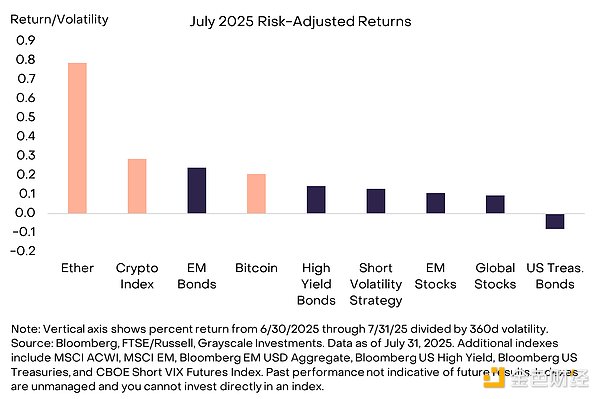
#### 1. Let’s Not Call It a "Rebound"
As the largest smart contract platform by market capitalization, Ethereum serves as critical infrastructure for blockchain-based financial systems. However, until recently, ETH’s price performance lagged significantly behind Bitcoin—and other smart contract platforms like Solana—sparking questions about its strategic direction and competitive standing (Chart 2).
**Chart 2: ETH Has Outperformed Bitcoin Since May**
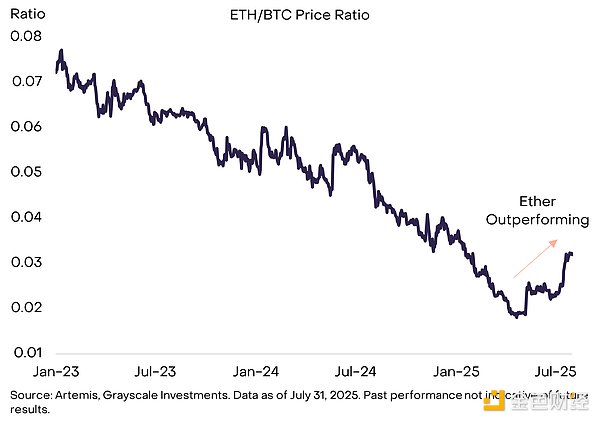
Renewed enthusiasm for Ethereum and ETH likely reflects a shift in focus toward stablecoins, asset tokenization, and institutional blockchain applications—areas where Ethereum holds core advantages over rival platforms (Chart 3). For example, including its layer-2 networks, the Ethereum ecosystem hosts over 50% of stablecoin balances and processes approximately 45% of U.S. dollar-denominated stablecoin transactions. The platform also accounts for 65% of total locked value in decentralized finance (DeFi) protocols and nearly 80% of tokenized U.S. Treasury products. For institutions with crypto exposure—such as Coinbase, Kraken, Robinhood, and Sony—Ethereum remains the preferred underlying network.
**Chart 3: Ethereum Leads in Stablecoins and Tokenized Assets**
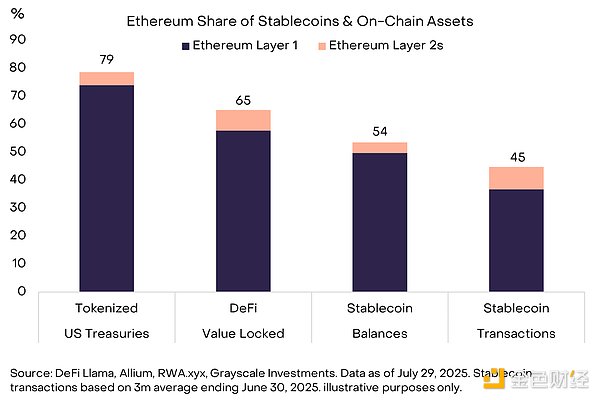
Growing adoption of stablecoins and tokenized assets will benefit both Ethereum and other smart contract platforms. Grayscale Research believes stablecoins could reshape segments of the global payments industry through lower costs, faster settlements, and greater transparency. This creates two stablecoin-related revenue streams: net interest margins (NIM) for issuers like Tether and Circle, and transaction fees for the chains processing trades. With its leading position in stablecoins, Ethereum’s ecosystem is likely to capture higher transaction fee revenue as adoption grows.
The same logic applies to tokenization—the process of bringing traditional assets onto blockchains. While the current tokenized asset market remains small (approximately $12 billion in total), it shows significant growth potential. Tokenized U.S. Treasuries are the largest asset class, with Ethereum dominating this space. In alternative assets, Apollo Global recently partnered with Securitize to launch an on-chain credit fund. Tokenized equities, though smaller, are growing rapidly: Robinhood introduced tokenized shares of private companies like SpaceX and OpenAI, while eToro announced plans to tokenize stocks on Ethereum. Apollo’s product supports multiple chains, but Robinhood and eToro’s tokenized equity offerings will be exclusive to the Ethereum ecosystem.
#### 2. ETP Inflows and Their Impact
Investor interest in Ethereum drove significant net inflows into spot ETH exchange-traded products (ETPs). In July 2025, U.S.-listed spot ETH ETPs saw $5.4 billion in net inflows—the largest monthly inflow since the products launched last year (Chart 4). Total ETH ETP holdings now stand at approximately $21.5 billion (equivalent to nearly 6 million ETH), accounting for roughly 5% of ETH’s circulating supply. Based on data from the U.S. Commodity Futures Trading Commission’s (*CFTC*) *Commitments of Traders* report, we estimate only $1–2 billion of these inflows reflect hedge fund "basis trades," with the remainder representing pure long positions.
**Chart 4: ETH ETP Inflows Surpass $5 Billion**
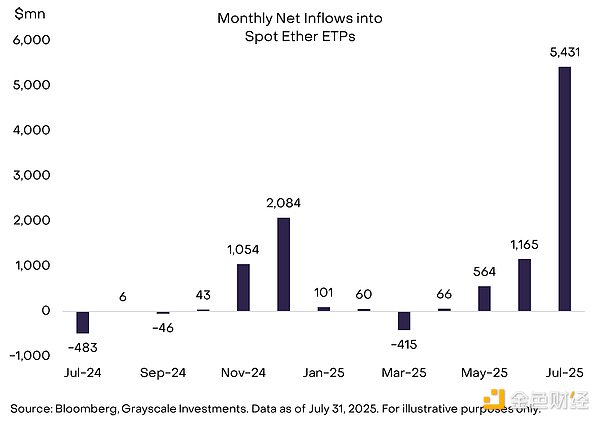
Several public companies have also begun accumulating ETH, offering token exposure to investors through equity instruments. The two largest "crypto asset treasury companies" holding ETH are Bitmine Emersion Technologies (ticker: BMNR) and SharpLink Gaming (ticker: SBET). Together, they hold over 1 million ETH, worth $3.9 billion. A third public company, BTCS (ticker: BTCS), announced in late July plans to raise $2 billion through common and preferred stock offerings to增持 ETH (BTCS currently holds approximately 70,000 ETH, worth $250 million). Beyond ETP inflows, buying demand from corporate treasury companies likely contributed to ETH’s price gains.
Meanwhile, Ethereum’s share of the crypto derivatives market rose this month, indicating growing speculative interest in the asset. Among traditional futures contracts listed on the Chicago Mercantile Exchange (CME), ETH futures open interest (OI) grew to approximately 40% of Bitcoin (BTC) futures OI (Chart 5). In perpetual futures, ETH’s OI reached roughly 65% of BTC’s OI. ETH perpetual futures trading volume also surpassed BTC’s in July.
**Chart 5: Growth in ETH Futures Open Interest**
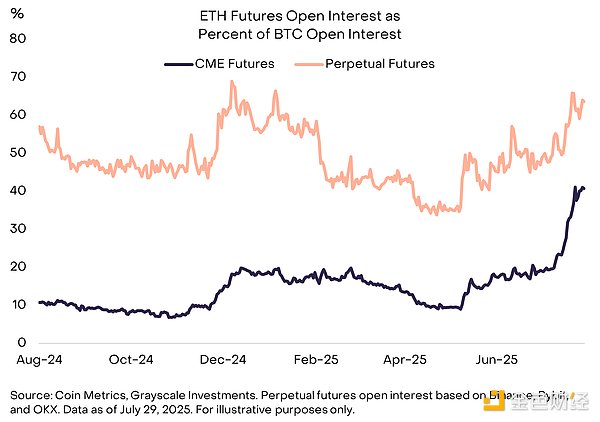
Despite Ethereum’s spotlight in July, Bitcoin investment products maintained steady inflows. U.S.-listed spot Bitcoin ETPs saw $6 billion in net inflows, with current holdings estimated at 1.3 million BTC. Several public companies expanded their Bitcoin treasury strategies: industry leader Strategy (formerly MicroStrategy) issued $2.5 billion in new preferred stock to buy more Bitcoin; Bitcoin pioneer and Blockstream CEO Adam Back announced a new Bitcoin treasury company, Bitcoin Standard Treasury Company (ticker: BSTR), which will use Bitcoin holdings from Back and other early adopters as capital, alongside equity fundraising. BSTR’s structure closely resembles Cantor Fitzgerald’s earlier SPAC (special purpose acquisition company) deal for Twenty One Capital—a Bitcoin treasury firm backed by Tether and SoftBank.
#### 3. The Altcoin Surge
Valuations across crypto market segments rose broadly in July. By industry classification, smart contract platforms performed best (benefiting from ETH’s 49% gain), while AI-focused tokens lagged (dragged down by idiosyncratic weakness in select tokens) (Chart 6). Futures open interest and funding rates (the cost of leveraged long positions) rose in tandem for most crypto assets, indicating increased investor risk appetite and growing speculative net long positions.
**Chart 6: Broad-Based Rally in Crypto Markets in July**

After a period of strong returns, valuations always face risks of correction or consolidation. While the *GENIUS Act* provided a major positive catalyst for crypto assets (explaining both strong absolute and risk-adjusted returns), legislative momentum may fade in the short term. U.S. Congress is debating crypto market structure legislation (the House-passed *CLARITY Act* gained bipartisan support on July 17), but the Senate is advancing its own version, with little progress expected before September.
Nonetheless, we remain bullish on the asset class in the coming months. First, regulatory tailwinds can persist without new legislation: the White House’s recent digital asset report outlined 94 specific recommendations (60 within regulators’ purview, 34 requiring congressional or interagency action). Second, regulators can continue guiding incremental capital into the market by approving staking features and expanding the range of spot crypto ETPs.
Additionally, we expect the macroeconomic environment to remain favorable for crypto assets—providing exposure to blockchain innovation while hedging specific risks in traditional assets. Beyond signing crypto-related legislation in July, President Trump enacted the *One Big Beautiful Bill Act (OBBBA)*, institutionalizing massive federal budget deficits over the next decade. Trump has also explicitly called for Federal Reserve rate cuts, emphasizing that a weaker dollar would benefit U.S. manufacturers, while imposing tariffs on various products and trading partners. Sustained large deficits and low real interest rates could suppress the dollar’s value, especially with White House acquiescence. Scarce digital commodities like Bitcoin and ETH may benefit from this environment, serving as partial hedges against a weakening dollar in investment portfolios.
Disclaimer: The views expressed herein are solely those of the authors and do not constitute investment advice from this platform. This platform makes no guarantees regarding the accuracy, completeness, originality, or timeliness of the information contained in this article, nor shall it be liable for any losses arising from the use or reliance on such information.
Contact: Sarah
Phone: +1 6269975768
Tel: +1 6269975768
Email: xttrader777@gmail.com
Add: Lee Garden One, 33 Hysan Avenue, Causeway Bay, Hong Kong.